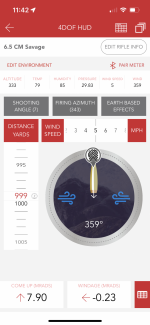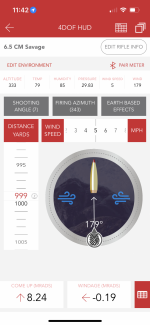Hello fellow marksmen,
I am seeking some insights into a discrepancy I have been experiencing between the predictions of my ballistic calculator (Hornady 4DOF) and my real-world shooting results. I typically shoot at 1000yard range, with a Savage 110 Tactical, Oryx chassis, chambered in 6.5 Creedmoor that’s had about 500-800 rounds of hand loaded Hornady Brass with 41 grains of H4350 for about 2750 fps. Here are the specifics of my setup and the statistics from my shots:
• Rifle: Savage 110 Tactical (6.5 Creedmoor)
• Barrel Twist: 1 in 8”
• Muzzle Velocity: 2750 FPS
• Zero Range: 100 yards
• Sight Height: 2.17 inches
• Axial Form Factor: 1.00
• Bore Diameter: 6.5mm
Shooting Stats (last session):
• Number of Shots: 42
• Max Velocity: 2769 FPS
• Min Velocity: 2737 FPS
• ES: 32
• Avg Velocity: 2750 FPS
• SD: 9.1
I have been meticulous in entering all the relevant data into the Hornady 4DOF and other ballistic apps. However, when shooting at 1000 yards, the calculators suggest an elevation adjustment of 8.24 Mrads, but I find myself needing to dial in 8.7 Mrads to hit the target accurately.
Moreover, I’ve noticed an interesting phenomenon regarding wind effects. When shooting with a 5mph tailwind, the elevation adjustment remains at 8.24 Mrads. However, when shooting into a 5mph headwind, the adjustment changes to 7.90 Mrads, contrary to what I would intuitively expect.
Additionally, I am considering the process of truing my ballistic calculator to my rifle to enhance its accuracy in predicting the necessary adjustments. However, I have noticed that other members of my long range club do not seem to face such discrepancies between their Kestrel ballistic calculators and their rifles. They mostly get on-point predictions with minimal deviations. Is truing a standard practice I should pursue, or might there be other underlying issues with my setup or data entry that could be leading to these discrepancies? I am open to any and all suggestions that could help in narrowing down, rectifying this issue.
I am keen to understand the reasons behind these discrepancies and correct for them to improve my accuracy. I would greatly appreciate
I am seeking some insights into a discrepancy I have been experiencing between the predictions of my ballistic calculator (Hornady 4DOF) and my real-world shooting results. I typically shoot at 1000yard range, with a Savage 110 Tactical, Oryx chassis, chambered in 6.5 Creedmoor that’s had about 500-800 rounds of hand loaded Hornady Brass with 41 grains of H4350 for about 2750 fps. Here are the specifics of my setup and the statistics from my shots:
• Rifle: Savage 110 Tactical (6.5 Creedmoor)
• Barrel Twist: 1 in 8”
• Muzzle Velocity: 2750 FPS
• Zero Range: 100 yards
• Sight Height: 2.17 inches
• Axial Form Factor: 1.00
• Bore Diameter: 6.5mm
Shooting Stats (last session):
• Number of Shots: 42
• Max Velocity: 2769 FPS
• Min Velocity: 2737 FPS
• ES: 32
• Avg Velocity: 2750 FPS
• SD: 9.1
I have been meticulous in entering all the relevant data into the Hornady 4DOF and other ballistic apps. However, when shooting at 1000 yards, the calculators suggest an elevation adjustment of 8.24 Mrads, but I find myself needing to dial in 8.7 Mrads to hit the target accurately.
Moreover, I’ve noticed an interesting phenomenon regarding wind effects. When shooting with a 5mph tailwind, the elevation adjustment remains at 8.24 Mrads. However, when shooting into a 5mph headwind, the adjustment changes to 7.90 Mrads, contrary to what I would intuitively expect.
Additionally, I am considering the process of truing my ballistic calculator to my rifle to enhance its accuracy in predicting the necessary adjustments. However, I have noticed that other members of my long range club do not seem to face such discrepancies between their Kestrel ballistic calculators and their rifles. They mostly get on-point predictions with minimal deviations. Is truing a standard practice I should pursue, or might there be other underlying issues with my setup or data entry that could be leading to these discrepancies? I am open to any and all suggestions that could help in narrowing down, rectifying this issue.
I am keen to understand the reasons behind these discrepancies and correct for them to improve my accuracy. I would greatly appreciate


